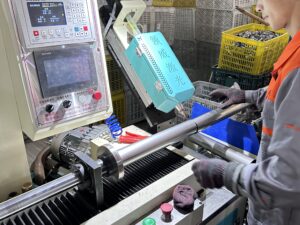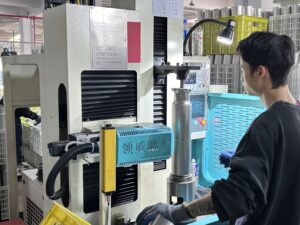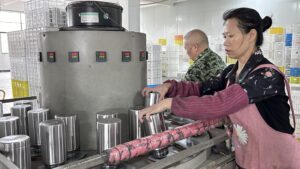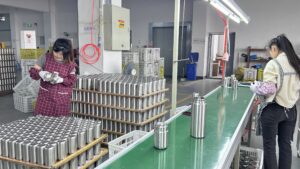Em Diller, Na Diller Factory, orgulhamo-nos de utilizar um processo preciso e bem gerido para produzir garrafas isoladas de aço inoxidável de qualidade superior. Se estiver curioso sobre como fazemos garrafas isoladas na fábrica Diller, verá que para garantir segurança, longevidade e desempenho de isolamento superior, cada garrafa que produzimos passa por várias etapas de produção. É assim que produzimos garrafas com isolamento na Fábrica Diller, começando com as matérias-primas e terminando com a embalagem.
1. Seleção das matérias-primas
O nosso processo de fabrico começa com aço inoxidável cuidadosamente selecionado, normalmente de grau 304 ou 316, que é conhecido pela sua capacidade de resistir à corrosão e garantir a segurança alimentar. Compreender como fabricamos garrafas com isolamento térmico na Fábrica Diller implica garantir que cada garrafa satisfaz as normas globais de saúde e qualidade, uma vez que apenas adquirimos materiais certificados.
2. Cortar em fatias
De acordo com o desenho da garrafa, as chapas de aço inoxidável são cortadas nas dimensões corretas. A consistência é garantida, o desperdício é reduzido e é estabelecida uma forma de garrafa consistente através de um corte de precisão, reflectindo o processo meticuloso de como fazemos garrafas isoladas na Fábrica Diller.
3. Extensão
As prensas hidráulicas são utilizadas para esticar as peças de metal cortadas até à forma básica da garrafa. A manutenção da resistência e da espessura da parede, que são essenciais para um isolamento adequado, exige um controlo cuidadoso durante esta fase.
4. Formação
Após o estiramento, aperfeiçoamos a forma do corpo da garrafa. Para dar a cada garrafa um design limpo e ergonómico, esta etapa implica o corte e a moldagem para garantir que a superfície é simétrica e lisa.
5. Limpeza
Em seguida, procedemos a uma limpeza profunda dos corpos das garrafas para eliminar quaisquer resíduos remanescentes relacionados com a moldagem, tais como óleo e pó de metal. As ligações fortes durante os processos subsequentes, como a soldadura e o revestimento, são asseguradas por superfícies limpas.
6. Soldadura das camadas interior e exterior
As nossas garrafas isoladas têm duas paredes. Para criar um espaço de vácuo selado que regula eficazmente a temperatura, soldamos com precisão as camadas interior e exterior. Para que a soldadura funcione verdadeiramente como isolamento, tem de ser completamente hermética.
7. Extração por vácuo
Para criar um vácuo, retiramos o ar do espaço entre as duas paredes. O segredo para manter as bebidas quentes ou frias durante horas é esta camada de vácuo. Cada produto é isolado de forma consistente graças à nossa maquinaria de extração a vácuo de última geração.
8. Brilhante
As garrafas são polidas para eliminar defeitos e dar-lhes um acabamento brilhante e refletor depois de serem aspiradas. Além disso, o polimento facilita os tratamentos de superfície subsequentes, como o revestimento a pó ou a pintura.
9. Ensaio da temperatura
Testamos a temperatura de amostras aleatórias antes de prosseguirmos. Ao avaliar a eficácia do isolamento, estes testes garantem que cada garrafa cumpre os requisitos do Diller.
10. Revestimento ou pintura a pó
Depois disso, aplicamos revestimentos exteriores para proteção e estética. As garrafas podem ser gravadas a laser, revestidas a pó ou pintadas com spray, consoante o modelo. Utilizamos materiais duradouros, seguros e amigos do ambiente.
11. Exame
Cada garrafa é submetida a uma rigorosa inspeção de qualidade, que inclui a avaliação da qualidade da superfície, verificações de retenção de vácuo e testes de fugas. Compreender como fabricamos garrafas térmicas na Fábrica Diller é crucial, e garantimos que apenas os produtos perfeitos passam para a fase seguinte.
12. Embalagem
Por fim, embalamos as garrafas com cuidado para a entrega. O nosso procedimento de embalagem é efectuado para garantir que as garrafas são entregues aos nossos clientes em todo o mundo sem serem riscadas ou danificadas durante o transporte.
A nossa dedicação
Como fabricante qualificado de garrafas de água, sabemos que a segurança e a qualidade são fundamentais. Cada fase deste processo reflecte o nosso esforço para desenvolver produtos em que os consumidores possam confiar e gostar de utilizar diariamente. Damos prioridade à precisão, responsabilidade e sustentabilidade em tudo, desde a seleção de materiais à embalagem.












